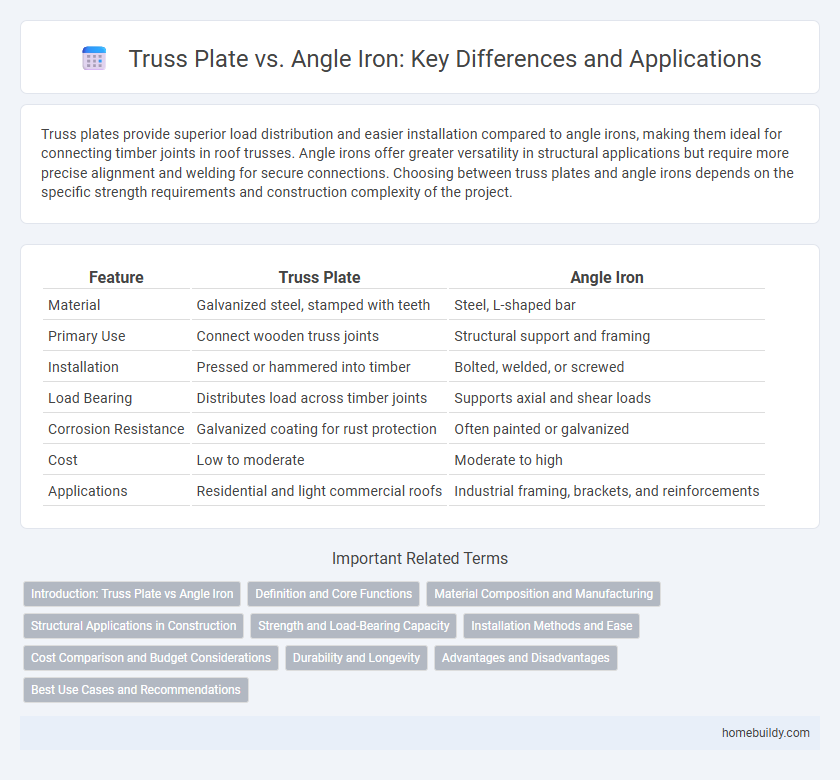Truss plates provide superior load distribution and easier installation compared to angle irons, making them ideal for connecting timber joints in roof trusses. Angle irons offer greater versatility in structural applications but require more precise alignment and welding for secure connections. Choosing between truss plates and angle irons depends on the specific strength requirements and construction complexity of the project.
Table of Comparison
| Feature | Truss Plate | Angle Iron |
|---|---|---|
| Material | Galvanized steel, stamped with teeth | Steel, L-shaped bar |
| Primary Use | Connect wooden truss joints | Structural support and framing |
| Installation | Pressed or hammered into timber | Bolted, welded, or screwed |
| Load Bearing | Distributes load across timber joints | Supports axial and shear loads |
| Corrosion Resistance | Galvanized coating for rust protection | Often painted or galvanized |
| Cost | Low to moderate | Moderate to high |
| Applications | Residential and light commercial roofs | Industrial framing, brackets, and reinforcements |
Introduction: Truss Plate vs Angle Iron
Truss plates offer a flat, perforated design optimized for evenly distributing loads in wooden structures, enhancing joint stability and structural integrity. Angle iron, characterized by its L-shaped cross-section, provides sturdy support primarily in steel frameworks but may require additional fastening for wood connections. Understanding the material compatibility and load distribution properties of truss plates versus angle iron is crucial for selecting the appropriate component in construction projects.
Definition and Core Functions
Truss plates are flat, perforated steel connectors designed to join wood members in truss construction, providing strong, efficient load transfer through embedded metal teeth. Angle irons, also known as L-brackets, are L-shaped steel bars primarily used for reinforcing, bracing, or framing, offering structural support with a focus on corner connections and stability. While truss plates specialize in distributing forces across wood joints, angle irons serve a broader role in metal and wood structural reinforcement.
Material Composition and Manufacturing
Truss plates are typically made from galvanized steel with punched or pressed teeth designed for secure wood fastening, manufactured using precision stamping to ensure uniformity and strength. Angle irons are composed of structural steel or aluminum, formed through hot or cold rolling processes to create L-shaped sections for load-bearing applications. The material composition and manufacturing methods of truss plates prioritize flexibility and embedding capability, whereas angle irons emphasize rigidity and external support.
Structural Applications in Construction
Truss plates provide efficient load distribution and uniform stress transfer in structural connections, making them ideal for prefabricated wooden trusses used in roof and floor systems. Angle iron, while versatile for general framing and bracing, lacks the precise load-bearing optimization of truss plates in engineered truss assemblies. The use of truss plates enhances joint stability and durability in repetitive structural applications, optimizing performance in construction projects.
Strength and Load-Bearing Capacity
Truss plates provide superior strength through multiple teeth that distribute load evenly across wooden members, enhancing load-bearing capacity in timber structures. Angle iron relies on its L-shaped steel profile, offering good support mainly in shear and bending but with less surface contact area compared to truss plates. For heavy-duty applications requiring enhanced load distribution and joint stability, truss plates outperform angle iron in both strength and load-bearing efficiency.
Installation Methods and Ease
Truss plates offer faster installation as they are typically pressed or punched directly into the wood, requiring minimal tools and labor compared to angle irons which need drilling and bolting for secure attachment. Angle irons demand precise alignment and often involve welding or heavy-duty fasteners, making the installation process more time-consuming and labor-intensive. The simplicity of truss plate installation reduces labor costs and project timelines while ensuring strong joint connections.
Cost Comparison and Budget Considerations
Truss plates generally offer a more cost-effective solution compared to angle irons due to lower manufacturing and installation expenses, making them ideal for budget-conscious projects. Angle irons, while often providing greater structural rigidity, tend to have higher material and labor costs, which can significantly increase overall expenditures. Careful budget considerations should assess the trade-off between initial costs of truss plates and the long-term benefits or expenses associated with angle iron reinforcements.
Durability and Longevity
Truss plates offer superior durability compared to angle irons due to their design, which distributes stress evenly across timber joints, reducing fatigue and wear. Made from galvanized steel, truss plates resist corrosion and maintain structural integrity over decades, outperforming angle irons that may be prone to rust and deformation under heavy loads. Their long-lasting performance in various environmental conditions makes truss plates the preferred choice for robust, enduring wood frame construction.
Advantages and Disadvantages
Truss plates offer superior load distribution and ease of installation compared to angle irons, making them ideal for prefabricated wood trusses due to their lightweight and corrosion-resistant galvanized steel construction. However, angle irons provide greater structural rigidity and versatility in custom metal framing applications but require more labor-intensive welding or bolting, increasing installation time and cost. Choosing between truss plates and angle irons depends on the specific structural requirements, with truss plates excelling in cost-effective, high-strength connections for timber, while angle irons suit projects demanding heavier load-bearing metal frameworks.
Best Use Cases and Recommendations
Truss plates excel in providing strong, quick connections in wooden frameworks, making them ideal for roof trusses and prefabricated structures where uniform load distribution is crucial. Angle iron offers versatile support in metal fabrication and structural reinforcements, best suited for heavy-duty framing and corner bracing in steel construction. Use truss plates for optimized wood joint integrity and angle iron when metal strength and right-angle support are prioritized.
Truss plate vs Angle iron Infographic

 homebuildy.com
homebuildy.com